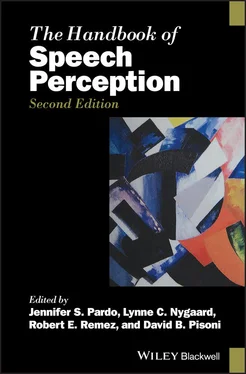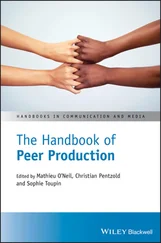Influences in early infant speech behavior have also been shown from the other direction. Speech‐production tendencies can be correlated with developing perceptual abilities (e.g. Majorano, Vihman, & DePaolis, 2014; DePaolis, Vihman, & Keren‐Portnoy, 2011). Majorano, Vihman, and DePaolis (2014) tested children learning Italian at 6, 12, and 18 months. At the end of the first year, children whose production favored a single vocal motor pattern, showed a perceptual preference for sounds resulting from those speech movement patterns.
None of these findings, however, elucidate how auditory feedback processing develops, nor what role hearing your own productions plays in learning to pronounce words. The findings of MacDonald et al. (2012) raise the possibility that early productions by the child are not tuning the word‐formation system on the basis of auditory‐error corrections. Instead, the early focus may be on the adult models. Cooper, Fecher, and Johnson (2018) recently showed that two‐and‐a‐half‐year‐old children preferred recordings of adults over recordings of their own and other toddlers’ speech. In fact, the children showed no familiarity effect and thus did not prefer their mother’s speech from another adult’s. As Cooper, Fecher, and Johnson (2018) suggest, the driving force in lexical acquisition may be the adult targets and not the successive shaping of children’s targets by corrective auditory feedback.
Howard and Messum (2011, 2014, Messum & Howard, 2015) have proposed a model of early word pronunciation that is consistent with this idea. According to their view, infants develop a set of vocal motor schemes (Vihman, 1991, 1993, 1996) during babbling. When early word learning takes place, infants are producing sounds that parents reinforce in the context. By this account, it is the adult who is initially solving the correspondence problem of perceiving the match between the children’s production and the adult target. Adult modeling and reinforcement guide the infants’ early lexical acquisition. Using their computational model called Elija, Howard and Messum have shown that early productions can be acquired by the model learning the associations between “infant” motor patterns and the acoustics of the adult produced in that context.
One of the key requirements for successful reinforcement learning is exploration. Sampling the control space allows the organism to learn the value of a range of different actions. In vocal learning, variability of productions allows the learner to produce a broad range of activities that can be selectively reinforced. In adult movement, it may be desirable to reduce or control peripheral or execution variability (Harris & Wolpert, 1998). However, variability such as that generated in the birdsong circuitry indicates that this type of “noise” is an essential part of the sensorimotor system (Bertram et al., 2014). Motor learning may require this variability (Dhawale, Smith, & Ölveczky, 2017) and the variable behavior of toddlers learning to produce speech may be showing exactly the prerequisite talking required to be vocal learners.
In summary, it is clear that hearing yourself speak is important to speech motor control. The precision and regularity of articulation seem to depend on auditory feedback. However, how this process works is less clear. The considerable hysteresis of degradation shown when profound hearing loss occurs, or when artificial modifications of speech feedback are introduced, suggests that auditory feedback may be an important stabilizing force in the long term but it is not essential for moment‐to‐moment control. Further, the data show that hearing others speak involves a different process from the perception of the sound of your own speech. The loose relationship shown between perceptual and production individual differences is consistent with the hypothesis that perception and production are largely separate but can influence each other at times (Dell & Chang, 2014; Kittredge & Dell, 2016).
1 Békésy, G. v. (1949). The structure of the middle ear and the hearing of one’s own voice by bone conduction. Journal of the Acoustical Society of America, 21(3), 217–232.
2 Bell‐Berti, F., Raphael, L. J., Pisoni, D. B., & Sawusch, J. R. (1979). Some relationships between speech production and perception. Phonetica, 36(6), 373–383.
3 Bertram, R., Daou, A., Hyson, R. L., et al. (2014). Two neural streams, one voice: Pathways for theme and variation in the songbird brain. Neuroscience, 277, 806–817.
4 Best, C. T., Goldstein, L. M., Nam, H., & Tyler, M. D. (2016). Articulating what infants attune to in native speech. Ecological Psychology, 28(4), 216–261.
5 Binnie, C. A., Daniloff, R. G., & Buckingham, H. W., Jr. (1982). Phonetic disintegration in a five‐year‐old following sudden hearing loss. Journal of Speech and Hearing Disorders, 47(2), 181–189.
6 Borden, G. J. (1979). An interpretation of research on feedback interruption in speech. Brain and Language, 7(3), 307–319.
7 Bridgeman, B. (2007). Efference copy and its limitations. Computers in Biology and Medicine, 37(7), 924–929.
8 Brown, R. (1958). Words and things. New York: Free Press.
9 Bruderer, A. G., Danielson, D. K., Kandhadai, P., & Werker, J. F. (2015). Sensorimotor influences on speech perception in infancy. Proceedings of the National Academy of Sciences of the United States of America, 112(44), 13531–13536.
10 Brumm, H., & Zollinger, S. A. (2011). The evolution of the Lombard effect: 100 years of psychoacoustic research. Behaviour, 148(11–13), 1173–1198.
11 Burnett, T. A., Freedland, M. B., Larson, C. R., & Hain, T. C. (1998). Voice F0 responses to manipulations in pitch feedback. Journal of the Acoustical Society of America, 103(6), 3153–3161.
12 Chang, E. F., Niziolek, C. A., Knight, R. T., et al. (2013). Human cortical sensorimotor network underlying feedback control of vocal pitch. Proceedings of the National Academy of Sciences of the United States of America, 110(7), 2653–2658.
13 Chase, R. A., Sutton, S., First, D., & Zubin, J. (1961). A developmental study of changes in behavior under delayed auditory feedback. Journal of Genetic Psychology, 99(1), 101–112.
14 Choi, D., Bruderer, A. & Werker, J. (2019). Sensorimotor influences on speech perception in pre‐babbling infants: Replication and extension of Bruderer et al. (2015). Psychonomic Bulletin & Review, 26, 1388–1399.
15 Christoffels, I. K., Formisano, E., & Schiller, N. O. (2007). Neural correlates of verbal feedback processing: An fMRI study employing overt speech. Human Brain Mapping, 28(9), 868–879.
16 Cooper, A., Fecher, N., & Johnson, E. K. (2018). Toddlers’ comprehension of adult and child talkers: Adult targets versus vocal tract similarity. Cognition, 173, 16–20.
17 Cooper, W. E. (1974). Selective adaptation for acoustic cues of voicing in initial stops. Journal of Phonetics, 2(4), 303–313.
18 Cooper, W. E., & Lauritsen, M. R. (1974). Feature processing in the perception and production of speech. Nature, 252(5479), 121–123.
19 Cowie, R., & Douglas‐Cowie, E. (1992). Postlingually acquired deafness. New York: Mouton de Gruyter.
20 Cowie, R., Douglas‐Cowie, E., & Kerr, A. G. (1982). A study of speech deterioration in post‐lingually deafened adults. Journal of Laryngology & Otology, 96(2), 101–112.
21 Crapse, T. B., & Sommer, M. A. (2008). Corollary discharge across the animal kingdom. Nature Reviews Neuroscience, 9(8), 587–600.
22 Creutzfeldt, O., Ojemann, G., & Lettich, E. (1989). Neuronal activity in the human lateral temporal lobe. Experimental Brain Research, 77(3), 451–475.
23 Cynx, J., Lewis, R., Tavel, B., & Tse, H. (1998). Amplitude regulation of vocalizations in noise by a songbird, Taeniopygia guttata. Animal Behaviour, 56(1), 107–113.
Читать дальше








![О Генри - Справочник Гименея [The Handbook of Hymen]](/books/407356/o-genri-spravochnik-gimeneya-the-handbook-of-hymen-thumb.webp)



